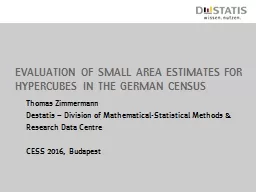

hypercubes in the German census Thomas Zimmermann Destatis Division of MathematicalStatistical Methods amp Research Data Centre CESS 2016 Budapest Background 21102016 Destatis Division of MathematicalStatistical Methods amp Research Data Centre ID: 577685
Download Presentation The PPT/PDF document "Evaluation of small area estimates for" is the property of its rightful owner. Permission is granted to download and print the materials on this web site for personal, non-commercial use only, and to display it on your personal computer provided you do not modify the materials and that you retain all copyright notices contained in the materials. By downloading content from our website, you accept the terms of this agreement.
Slide1
Evaluation of small area estimates for hypercubes in the German census
Thomas Zimmermann
Destatis
– Division
of
Mathematical-Statistical Methods & Research Data Centre
CESS 2016, BudapestSlide2
Background
21/10/2016
© Destatis| Division of Mathematical-Statistical Methods & Research Data Centre
Slide
2
Question:
Should we apply small area estimation methods in the next German Census?
Ongoing evaluation using Census data from 2011
Consider target variables, which are not included in the population register, e.g.:
Highest level of school education
Employment status (ILO definition)
Migrant status
Today’s talk:
Focus on the hypercube constructed as cross-classification of the migrant status with age-classes and sexSlide3
Hypercubes and small area estimation
21/10/2016
Slide
3
Estimates for the hypercube are desired on the county-level (NUTS3)
This yields 20600 hypercube cells (412 counties, 5 categories of the migrant status, 5 age-classes and two sexes)
Unplanned domains
Sample
sizes frequently too small to produce reliable direct estimates
for
hypercubes at the county-level (G)SPREE approaches are not directly applicable due to lack of register information
©
Destatis
| Division of Mathematical-Statistical Methods & Research Data CentreSlide4
Synthetic estimation approach
21/10/2016
Slide
4
Step 1
:
Obtain design-based direct estimates of the cell structure at an aggregated level
Step 2:
Adjust aggregated cell structure to reliably estimated margins at the county-level using a log-linear model
Variance estimation using the rescaling bootstrap to reflect both sources of uncertainty
Inspect synthetic estimates for potential biases
©
Destatis
| Division of Mathematical-Statistical Methods & Research Data CentreSlide5
Available diagnostics (Brown et al., 2001)
21/10/2016
© Destatis| Division of Mathematical-Statistical Methods & Research Data Centre
Slide
5
Bias diagnostics: Scatterplot of direct vs. synthetic estimates; Their ratio as a function of the sample size
G
oodness-of-fit diagnostic
Assumes validity of CLT in small areasCoverage diagnostic
Assumes independence between design-based and synthetic estimates
Valid for normally distributed estimates
Calibration diagnostic (
)Slide6
Precision of the estimates
21/10/2016
© Destatis| Division of Mathematical-Statistical Methods & Research Data Centre
Slide
6Slide7
Plausibility of synthetic estimates
21/10/2016
Slide
7
©
Destatis
| Division of Mathematical-Statistical Methods & Research Data CentreSlide8
Main findings
21/10/2016
Slide
8
Direct estimator suffers from small sample cell counts in many hypercube cells
Synthetic estimator achieves reduction in relative standard error
B
enchmarking
to
margins of the migrant status on the county-level may give rise to a bias-variance trade-off
In some states, benchmarking the migrant status on the state-level is the better choice
©
Destatis
| Division of Mathematical-Statistical Methods & Research Data CentreSlide9
Outlook and possible extensions
21/10/2016
Slide
9
Initial cell estimates could be obtained for groups defined by similar characteristics rather than administrative boundaries
Apply further tools
to check implicit assumptions based on sample data
Consider a
c
omposite estimator
Weights for a one-number Census© Destatis
| Division of Mathematical-Statistical Methods & Research Data Centre